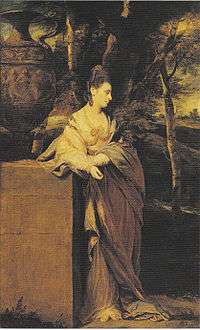John Parker, 1st Baron Boringdon

John Parker, 1st Baron Boringdon (1735 – 27 April 1788) was a British peer and Member of Parliament.
Origins
Parker was the eldest son of John Parker (1703–1768) of Boringdon Hall, Plympton, and Saltram House, by his wife Catherine Poulett (1706–1758), whom he married in 1725,[1] daughter of John Poulett, 1st Earl Poulett. He had a sister Henrietta Parker (d.1808) and a younger brother, Montagu Edmund Parker (1737–1813) of Whiteway House, near Chudleigh (purchased by his grandfather George Parker (d.1743) who also purchased Saltram), Sheriff of Devon in 1789, who married in 1775 Charity Ourry (1752–1786), daughter of Admiral Paul Ourry, by whom he had issue Montague E. Parker (1778–1831) whose daughter Harriet Parker (1809–1897) married in 1842, as her second husband, her second cousin Edmund Parker, 2nd Earl of Morley (1810–1864).
Career
He was educated at Christ Church, Oxford.
He was elected to the House of Commons for Bodmin in 1761, a seat he held until 1762, and then represented Devon between 1762 and 1784. The latter year Parker was raised to the peerage as Baron Boringdon, of Boringdon in the County of Devon.[2]
Apart from his political career he was also a collector of paintings at his seat Saltram House in Devon. He was elected a Fellow of the Royal Society in April 1767.[3] In 1783, Parker's horse Saltram won the fourth running of the Epsom Derby.
Marriage and progeny


Lord Boringdon married twice:
- Firstly, in 1764 to Frances Hort (d.1764), daughter of the Right Reverend Josiah Hort, Archbishop of Tuam. She died later the same year, without progeny.
- Secondly, in 1769, to Hon. Theresa Robinson (1744/5-1775), second daughter of Thomas Robinson, 1st Baron Grantham. Lord Boringdon survived her by thirteen years and had by her the following progeny:
- John Parker, 1st Earl of Morley (1772–1840), who was created Viscount Boringdon and Earl of Morley in 1815.
- Theresa Parker (1775–1856), who married George Villiers (1759–1827), youngest son of Thomas Villiers, 1st Earl of Clarendon. Their eldest son became George Villiers, 4th Earl of Clarendon.
Death and burial
Lord Boringdon died in April 1788.
Notes
- ↑ NT guidebook, p.65
- ↑ "PARKER, John (?1735-88), of Boringdon, Devon". History of Parliament Onlie. Retrieved 9 June 2016.
- ↑ "Lists of Royal Society Fellows 1660-2007". London: The Royal Society. Archived from the original on 24 March 2010. Retrieved 15 July 2010.
References
 Lee, Sidney, ed. (1895). "Parker, John (1772-1840)". Dictionary of National Biography. 43. London: Smith, Elder & Co.
Lee, Sidney, ed. (1895). "Parker, John (1772-1840)". Dictionary of National Biography. 43. London: Smith, Elder & Co. - Kidd, Charles, Williamson, David (editors). Debrett's Peerage and Baronetage (1990 edition). New York: St Martin's Press, 1990,
- Leigh Rayment's Peerage Pages
- Lundy, Darryl. "FAQ". The Peerage.
- National Trust guide book, Saltram, Devon, 2011, p. 65
| Parliament of Great Britain | ||
|---|---|---|
| Preceded by Sir William Irby George Hunt |
Member of Parliament for Bodmin with George Hunt 1761–1762 |
Succeeded by George Hunt Sir Christopher Treise |
| Preceded by Sir William Courtenay Sir Richard Warwick Bampfylde |
Member of Parliament for Devon with Sir Richard Warwick Bampfylde 1762–1776 John Rolle Walter 1776–1780 John Rolle 1780–1784 1762–1784 |
Succeeded by John Rolle John Pollexfen Bastard |
| Peerage of Great Britain | ||
| Preceded by New Creation |
Baron Boringdon 1784–1788 |
Succeeded by John Parker |